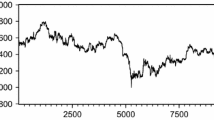Abstract
This study investigates the impact of index futures trading on the spot market volatility for Ho Chi Minh Stock Exchange (HOSE). The data used in this study are daily VN30-Index, future trading volume and open interests covering the period from March 18th, 2015 to January 2nd, 2020. In order to capture the asymmetric effect, the EGARCH(1,1) model is employed in this study. It is found that the introduction of index future trading leads to the increase the spot market volatility. In addition, our empirical findings reveal that the impact of recent news on spot market volatility in the post-index future period is greater that than the pre-index future period; and the market volatility in the post-futures period is more persistent than in the pre-futures period. Moreover, the level of asymmetric effect on the market volatility in the post-index future period is significantly lower than that for the pre-index futures period. Finally, the results derived from the Granger causality test confirm that the bi-directional causality relation between the spot market volatility and the future trading activity exists in HOSE.
Similar content being viewed by others
Notes
Exchange rate on December 31st 2019: 1 USD = 23,155 VND.
The authors also performs ARCH-LM testing with several lag orders and the basic results remain the same. Upon to request the results.
References
Antoniou, A., & Holmes, P. (1995). Futures trading, information and spot price volatility: Evidence for the FTSE-100 stock index futures contract using GARCH. Journal of Banking and Finance, 19, 117–129.
Bae, S. C., Kwon, T. H., & Park, J. W. (2004). Futures trading, spot market volatility, and market efficiency: The case of the Korean index futures markets. Journal of Futures Markets, 24(12), 1195–1228.
Bessembinder, H., & Seguin, P. J. (1992). Futures trading activity and stock price volatility. The Journal of Finance, 47(5), 2015–2034.
Board, J., Sandmann, G., & Sutcliffe, C. (2001). The effect of futures market volume on spot market volatility. Journal of Business Finance and Accounting, 28(7–8), 799–820.
Bollerslev, T. (1986). Generalized autoregressive conditional heteroskedasticity. Journal of Econometrics, 31, 307–327.
Bologna, P., & Cavallo, L. (2002). Does the introduction of index futures effectively reduce stock market volatility? Is the futures effect immediate? Evidence from the Italian Stock Exchange using GARCH. Applied Financial Economics, 12(3), 183–192.
Brooks, C. (2008). Introductory Econometrics for Finance. Cambridge, UK.: Cambridge University Press.
Chen, H., Han, Q., Li, Y., & Wu, K. (2013). Does index futures trading reduce volatility in the Chinese stock market? A panel data evaluation approach. Journal of Futures Markets, 33(12), 1167–1190.
Engle, R. F. (1982). Autoregressive conditional heteroscedasticity with estimates of the variance of United Kingdom inflation. Econometric, 50(4), 987–1007.
Garcia, P., Leuthold, R. M., & Zapata, H. (1986). Lead-lag relationship between trading volume and price variability: new evidence. Journal of Futures Markets, 6(1), 1–10.
Gulen, H., & Mayhew, S. (2000). Stock index futures trading and volatility in international equity markets. Journal of Futures Markets, 20(7), 661–685.
Illueca, M., & Lafuente, J. A. (2003). The effect of spot and futures trading on stock index volatility: A non-parametric approach. Journal of Futures Markets, 23(9), 841–858.
Kim, M., Kim, G. R., & Kim, M. (2004). Stock market volatility and trading activities in the KOSPI 200 derivative markets. Applied Economics Letter, 11(1), 49–53.
Lee, S. B., & Ohk, K. Y. (1992). Stock index futures listing and structural change in time-varying volatility. Journal of Futures Markets, 12(5), 493–509.
McKenzie, M. D., Brailsford, T. J., & Faff, R. W. (2001). New insights into the impact of the introduction of futures trading on stock price volatility. Journal of Futures Markets, 21(3), 237–255.
Nelson, D. B. (1991). Conditional heteroskedasticity in asset returns: A new approach. Econometrica, 59(2), 347–370.
Pericli, A., & Koutmos, G. (1997). Index futures and options and stock market volatility. Journal of Futures Markets, 17(8), 957–974.
Pilar, C., & Rafael, S. (2002). Does derivatives trading destabilize the underlying assets? Evidence from the Spanish stock market. Applied Economics Letters, 2(5), 113–126.
Pok, W. C., & Poshakwale, S. (2004). The impact of the introduction of futures contracts on the spot market volatility: The case of Kuala Lumpur Stock Exchange. Applied Financial Economics, 14(2), 143–154.
Rahman, S. (2001). The introduction of derivatives on the Dow Jones industrial average and their impact on the volatility of component stocks. Journal of Futures Markets, 21(7), 633–653.
Ramana Rao, S. V., & Tripathy, N. (2009). Impact of index derivatives on Indian stock market volatility—An application of ARCH and GARCH model. Corporate Ownership and Control, 6(3), 39–44.
Spyrou, S. I. (2005). Index futures trading and spot price volatility: Evidence from an emerging market. Journal of Emerging Market Finance, 4(2), 151–167.
Tripathy, N., Ramana Rao, S. V., & Kanagaraj, A. (2009). Impact of derivatives trading on spot market volatility: an empirical study. International Journal of Applied Decision Sciences, 2(2), 209–232.
Truong, D. L., Lanjouw, G., & Lensink, R. (2010). Stock-market efficiency in thin-trading markets: the case of the Vietnamese stock market. Applied Economics, 42, 3519–3532.
Verbeek, M. (2004). A guide to modern econometrics. Chichester, UK.: John Wiley & Sons.
Xie, S., & Huang, J. (2014). The impact of index futures on spot market volatility in China. Emerging Markets Finance and Trade, 50(1), 167–177.
Yu, S. W. (2001). Index futures trading and spot price volatility. Applied Economics Letters, 8(3), 183–186.
Author information
Authors and Affiliations
Corresponding author
Additional information
Publisher's Note
Springer Nature remains neutral with regard to jurisdictional claims in published maps and institutional affiliations.
Rights and permissions
About this article
Cite this article
Truong, L.D., Nguyen, A.T.K. & Vo, D.V. Index Future Trading and Spot Market Volatility in Frontier Markets: Evidence from Ho Chi Minh Stock Exchange. Asia-Pac Financ Markets 28, 353–366 (2021). https://doi.org/10.1007/s10690-020-09325-1
Accepted:
Published:
Issue Date:
DOI: https://doi.org/10.1007/s10690-020-09325-1




